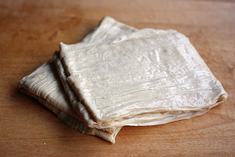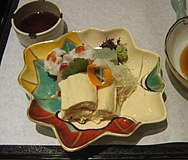
Miso is a traditional Japanese seasoning. It is a thick paste produced by fermenting soybeans with salt and kōji, and sometimes rice, barley, seaweed, or other ingredients. It is used for sauces and spreads; pickling vegetables, fish, or meats; and mixing with dashi soup stock to serve as miso soup, a Japanese culinary staple food. Miso is high in protein and rich in vitamins and minerals, and it played an important nutritional role in feudal Japan. Miso is widely used in both traditional and modern cooking in Japan, and as of 2018 had been gaining worldwide interest.
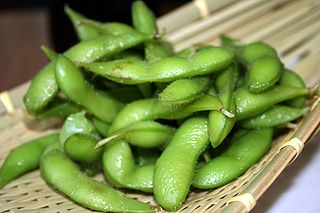
Edamame is an East Asian dish prepared with immature soybeans in their pods, which are boiled or steamed, and may be served with salt or other condiments. The dish has become popular across the world because it is rich in vitamins, dietary fiber, and isoflavones. When the beans are outside the pod, the term mukimame is also sometimes used in Japanese. Edamame are a common side dish in Japanese cuisine and as an appetizer to alcoholic beverages such as beer or shōchū. As an ingredient, edamame are found in both sweet and savory dishes such as takikomi gohan, tempura, and zunda-mochi.

Textured or texturized vegetable protein (TVP), also known as textured soy protein (TSP), soy meat, or soya chunks, is a defatted soy flour product, a by-product of extracting soybean oil. It is often used as a meat analogue or meat extender. It is quick to cook, with a protein content comparable to some meats.

Tempeh or tempe is a traditional Indonesian food made from fermented soybeans. It is made by a natural culturing and controlled fermentation process that binds soybeans into a cake form. A fungus, Rhizopus oligosporus or Rhizopus oryzae, is used in the fermentation process and is also known as tempeh starter.

Nattō is a traditional Japanese food made from whole soybeans that have been fermented with Bacillus subtilis var. natto. It is often served as a breakfast food with rice. It is served with karashi mustard, soy or tare sauce, and sometimes Japanese bunching onion. Within Japan, nattō is most popular in the eastern regions, including Kantō, Tōhoku, and Hokkaido.

Soy milk, also known as soya milk or soymilk, is a plant-based drink produced by soaking and grinding soybeans, boiling the mixture, and filtering out remaining particulates. It is a stable emulsion of oil, water, and protein. Its original form is an intermediate product of the manufacture of tofu. Originating in China, it became a common beverage in Europe and North America in the latter half of the 20th century, especially as production techniques were developed to give it a taste and consistency more closely resembling that of dairy milk. Soy milk may be used as a substitute for dairy milk by individuals who are vegan or lactose intolerant.

Amazake is a traditional sweet, low-alcohol or non-alcoholic Japanese drink made from fermented rice. Amazake dates from the Kofun period, and it is mentioned in the Nihon Shoki. It is part of the family of traditional Japanese foods made using the koji mold Aspergillus oryzae, which also includes miso, soy sauce, and sake.
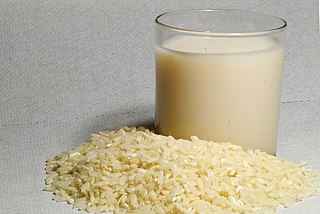
Rice milk is a plant milk made from rice. Commercial rice milk is typically manufactured using brown rice and brown rice syrup, and may be sweetened using sugar or sugar substitutes, and flavored by common ingredients, such as vanilla. It is commonly fortified with protein and micronutrients, such as vitamin B12, calcium, iron, or vitamin D.

Namagashi (生菓子) are a type of wagashi, which is a general term for traditional Japanese sweets and candies. Namagashi may contain fruit jellies, other gelatines such as Kanten, or sweetened bean paste. Namagashi is detailed, designed with using seasonal and natural motifs such as leaves and flowers to reflect the various objects of nature in Japan's four seasons. Namagashi are usually freshly made and are much more moist than other wagashi, like higashi. It generally contains 30% more water than other types. Like other wagashi, namagashi are made of natural ingredients; additives are rarely used. Namagashi is generally served with tea, and it's traditionally eaten on New Year's for good luck.

Fermented tofu is a Chinese condiment consisting of a form of processed, preserved tofu used in East Asian cuisine. The ingredients typically are soybeans, salt, rice wine and sesame oil or vinegar. In mainland China the product is often freshly distributed. In overseas Chinese communities living in Southeast Asia, commercially packaged versions are often sold in jars containing blocks 2- to 4-cm square by 1 to 2 cm thick soaked in brine with select flavorings.

Okara, soy pulp, or tofu dregs is a pulp consisting of insoluble parts of the soybean that remain after pureed soybeans are filtered in the production of soy milk and tofu. It is generally white or yellowish in color. It is part of the traditional cuisines of Japan, Korea, and China. Since the 20th century, it has been used in the vegetarian cuisines of Western nations.

Tofu is a food prepared by coagulating soy milk and then pressing the resulting curds into solid white blocks of varying softness: silken, soft, firm, extra firm. Tofu is translated as bean curd in English. Tofu originated in China and has been consumed in the country for over 2,000 years. Tofu is a traditional component of many East Asian and Southeast Asian cuisines; in modern Western cooking, it is often used as a meat substitute.
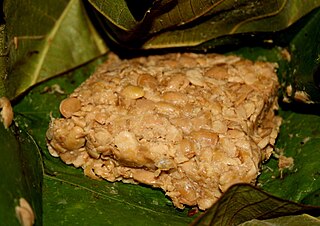
Kinema is a fermented soybean food, prepared by the Kirati communities of the Eastern Himalayas region: Eastern Nepal, and Darjeeling, Kalimpong and Sikkim regions of India. Kinema also known as Kinama, which is a traditional food of the Kirati people.
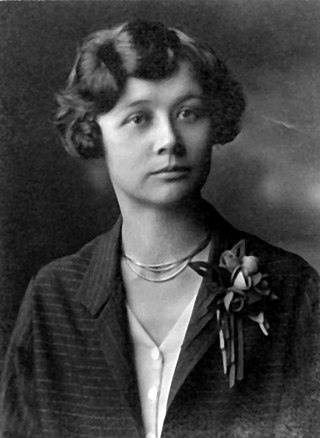
Mildred Mathilda Lager was an American pioneer of natural foods and health food.

Wotou or wowotou, also called Chinese cornbread, is a type of steamed bread made from cornmeal in Northern China.
Dr. Lo Kwee-seong, CBE, JP was a Hong Kong businessman, investor and philanthropist. He was the founder of the Vitasoy, a well-known soymilk drink company in Hong Kong. He was also an unofficial member of the Urban Council and the Legislative Council of Hong Kong and the chairman of the Hong Kong Consumer Council.

The Farm Vegetarian Cookbook is a vegan cookbook by Louise Hagler, first published in 1975. It was influential in introducing Americans to tofu, included recipes for making and using tempeh and other soy foods, and became a staple in vegetarian kitchens.

Harry Willis Miller was an American physician, thyroid surgeon and Seventh-day Adventist missionary. Miller was a vegetarian and pioneer in the development of soy milk.
William Roy Shurtleff also known as Bill Shurtleff is an American researcher and writer about soy foods. Shurtleff and his former wife Akiko Aoyagi have written and published consumer-oriented cookbooks, handbooks for small- and large-scale commercial production, histories, and bibliographies of various soy foods. These books introduced soy foods such as tofu, tempeh, and miso on a wide scale to non-Asian Westerners, and are largely responsible for the establishment of non-Asian soy food manufacturers in the West beginning in the late 1970s. In 1980, Lorna Sass wrote in The New York Times, "The two people most responsible for catapulting tofu from the wok into the frying pan are William Shurtleff and Akiko Aoyagi." In 1995, Suzanne Hamlin wrote in The New York Times, "At the turn of the century there were two tofu suppliers in the United States. Today there are more than 200 tofu manufacturers...and tofu can be found in nearly every supermarket."
Akiko Aoyagi is an American cookbook author and artist. She is best known as the recipe developer, illustrator, and co-author of the soy-based cookbook series The Book of Tofu (1975), The Book of Miso (1976), and The Book of Tempeh (1979), that had a strong impact on the natural foods and vegetarian movements within the American counterculture.
